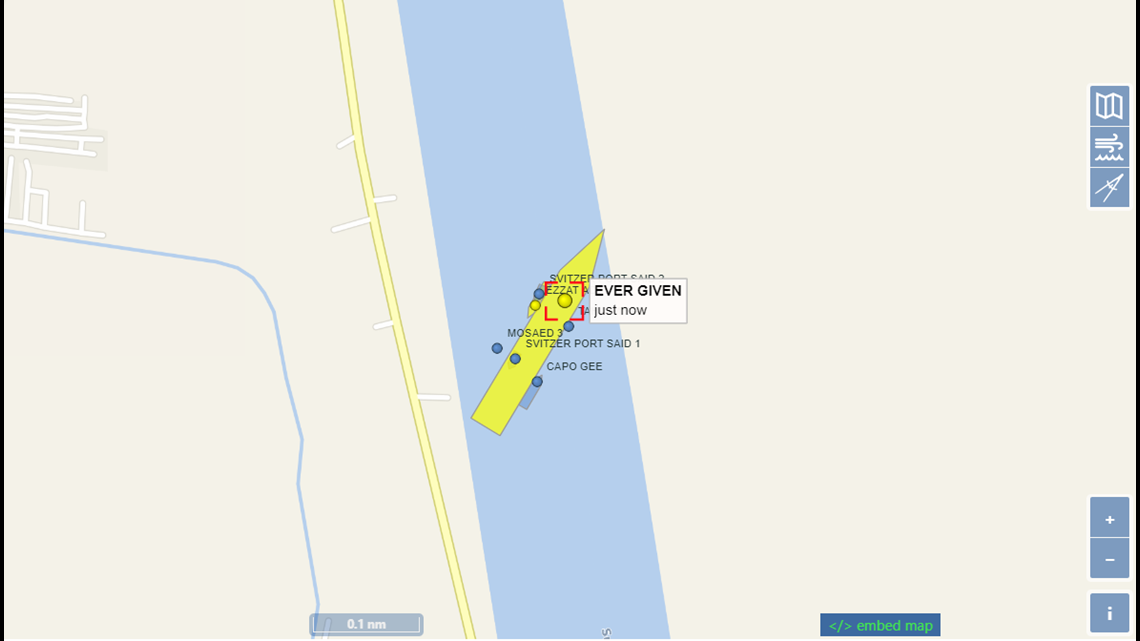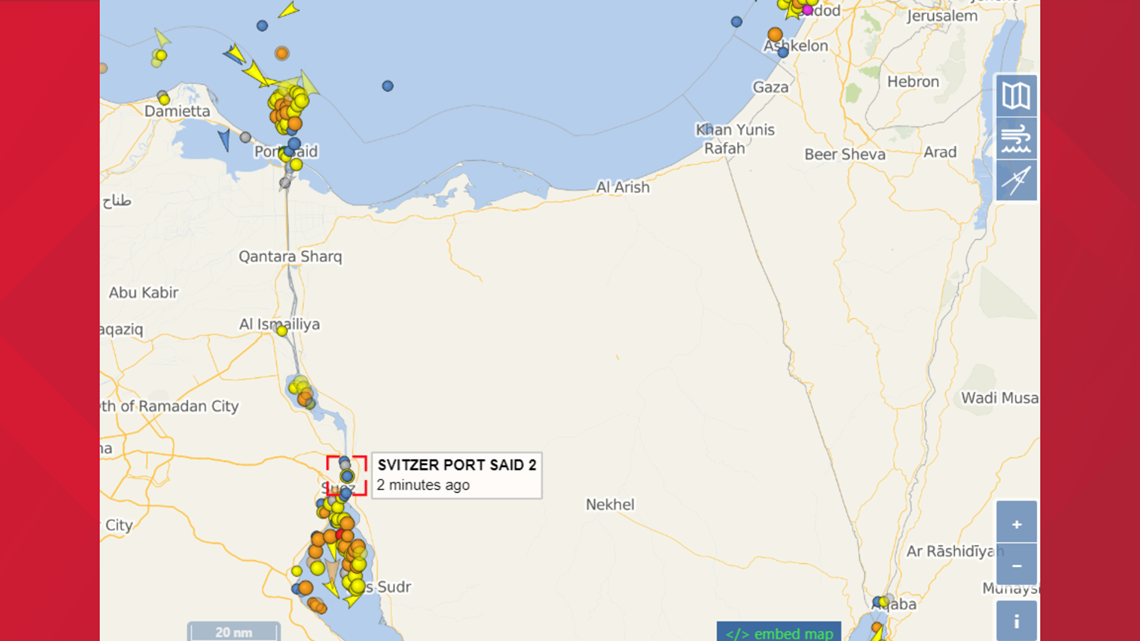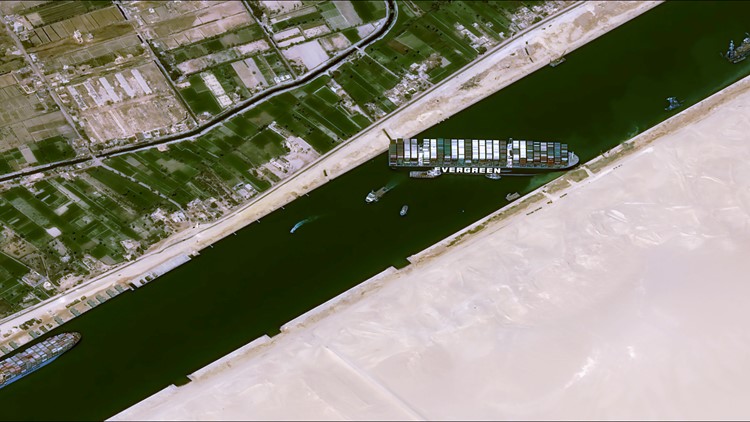No boats are traveling through the Suez Canal right now. Not because of any kind of maintenance, or because of inclement weather of some type. The Suez Canal is blocked because a boat is stuck.
A cargo ship called the Ever Given became stuck in the Suez Canal, the body of water that creates a shortcut between Europe and Asia, on March 23 not long after entering the Suez Canal from the Red Sea, the side closer to Asian ports. The massive boat has made the canal impassable and has been difficult to get moving again.
The problem is that the Suez Canal is one of the most vital waterways for shipping in the world. So the blockage has an impact on trade and economies across the world.
The sheer absurdity of the unfortunate situation has brought about a lot of attention on social media. One of the most viral posts has been a tweet with expletives that says the boat is blocking the Suez Canal “into literal gridlock & is currently costing every seafaring nation of Earth like millions of dollars every hour.”
THE QUESTION
How did a boat block the Suez Canal? Is this blockage costing countries massive sums of money?
WHY WE ARE VERIFYING
The situation has gained a lot of attention. It’s hard to imagine how it’s possible to block such a busy thoroughfare and the impact of it isn’t immediately clear.
THE ANSWER
According to the company that is leasing the ship, high winds led to its grounding. And because modern cargo ships are incredibly massive, that can be a problem for a narrow passage of water.
One estimate puts the total value of goods that move through the Suez Canal daily at over $9.5 billion. And there is no fast alternate route. Which means that’s over $9 billion worth of goods stopped per day for multiple days.
WHAT WE FOUND
Evergreen Marine Corp., which leases the Ever Given, said in a statement that gusting winds caused the ship to deviate from its course and lead to its grounding. A statement from the ship’s technical manager corroborated that statement.
And there’s no debate it has blocked traffic through the canal. The Suez Canal Authority declared that all navigation through it is suspended.
But how could a single grounded ship block an entire canal that supports traffic in both directions? Well, the boat is really, really big.
Its Vessel Finder bio states the ship is 400 meters long and 59 meters wide. That’s about 1,312 feet long — which is nearly a quarter-mile.
Another way to look at it: the Empire State Building is 1,250 feet tall at its highest floor and 1,454 feet tall at the tip of its antenna. So imagine someone laying out the Empire State Building across the Suez Canal.
The Suez Canal’s most narrow areas, which the ship is stuck in, are about 205 to 225 meters wide. That’s just over half as wide as the Ever Given is long. That’s… not good.
If you zoom in far enough on Vessel Finder’s map, you can actually see the positioning of each ship. Zoom in all the way on the Ever Given, at least as of March 25, and it’s clear why no one else is moving through the canal.


Those dots all around the boat in the screenshot are actually tug boats. They’re there because there is a massive operation underway to “re-float” the vessel. The Suez Canal Authority has referred to the usage of tug boats to pull it out. The ship’s technical manager said they were using dredgers to dig out sand and mud from underneath the boat’s bow. You can actually see photos of both methods in use on the Suez Canal Authority’s gallery at the bottom of their news page. They also posted a video of these efforts to their Facebook page.
Given the size of the boat and the amount of cargo it can hold, it’s extremely heavy. So efforts to move it with either method have failed to dislodge it as of yet.
But what’s the big deal? Why is everyone talking about this boat in an Egyptian canal on the other side of the world?
The Suez Canal Authority says 18,880 ships traveled through the canal in 2019 — that’s more than 51 boats a day. That doesn’t seem like much at first, but when you consider the amount of stuff these massive, slow-moving boats take through the 10-hour, 100-mile journey through the canal, you realize it begins to add up.
According to Lloyd’s List, a publication that has specialized in shipping news and research for several hundred years, 12% of global trade travels through the Suez Canal. They said the combined eastbound and westbound traffic through the canal carries about $9.6 billion worth of goods through it a day. They’ve catalogued 213 ships stuck waiting for passage through the canal, which Vessel Finder’s map helps visualize.


The reason the Suez Canal is so important is because the next fastest way for ships to get from a port on the Pacific Ocean, the Indian Ocean or the Arabian Sea to Europe is around the southern tip of Africa. That can add more than a week of transit time to the voyage.
A prolonged blockage — which is still possible with no timetable given for how long re-floating the boat will take — could cause significant economic issues. One such issue: a jump in the price of crude oil, which sometimes travels on ships piloted along the Suez Canal from the Arabian Sea to the United States. The potential impact was put on display on March 24 when the price of oil jumped after spending much of the past seven days dropping.
But there’s not much bystanders can do but laugh at the absurdity of it. So the jokes keep piling up with each passing day, just like the number of boats waiting to cross the Suez.











